IDP News Issue No. 26
WE WOULD LIKE TO TAKE THIS OPPORTUNITY TO WISH ALL OUR READERS A HAPPY NEW YEAR, FOR JANUARY 1 AND FOR THE CHINESE NEW YEAR OF THE DOG ON 29 JANUARY.
2005 - The New Year in Review

2005 has been such a successful and busy year for IDP that we decided to devote most of this issue to a review of our achievements to bring our readers up to date. These include the launch of the completely re-designed website, which contains much more functionality and is live in English, Chinese, Russian, Japanese and German versions. We hope you find it easier to use. An illustrated tour through the new site is given in Digitisation, Cataloguing & Research and will also be put online in 2006.
Right: A classroom in Gansu Province, China, where teachers are now using the IDP educational resource pack produced under the auspices of the Gansu Basic Educational Project (see Education).
Details of new and existing collaborations is given in IDP Worldwide, while a summary of IDP's digitisation, cataloguing and research projects — completed, ongoing and new — is in Digitisation, Cataloguing & Research. An update of education projects is here along with general news of IDP. The usual sections on conferences and recent publications have had to be moved to the next issue which will be out shortly. This issue is enhanced by an article by Professor Geng Shimin reviewing Uighur studies in China.
IDP's activities now truly extend well beyond working solely on manuscripts from the Library Cave at Dunhuang and, although the name 'IDP' and the logo will not change, we have decided to reflect this broader activity in IDP's overall objective. It now reads:
TO PROMOTE THE STUDY AND PRESERVATION OF THE ARCHAEOLOGICAL LEGACY OF THE EASTERN SILK ROAD THROUGH INTERNATIONAL CO-OPERATION.
NEW FUNDING
We are delighted to announce that over the past six months IDP has received major grants totalling USD1 million from the following bodies. These funds will enable many of IDP's activities worldwide for the next two years and we would like to thank the funders for their generous support. We would also like to thank the many smaller donors who continue to make our work possible.
The Leverhulme Trust: 3-year research project entitled: 'A Palaeographic Study of the Chinese and Tibetan Manuscripts from the Dunhuang Collections'.
The Pidem Fund: 5 years' funding for general IDP activities.
The Ford Foundation: 2-year project entitled: 'China, India, Russia: Bringing Together Scholars and Scholarly Resources on the Silk Road.'
The International Research Institute for Advanced Buddhology at Soka University: 3-year project to digitise and catalogue Sanskrit manuscripts in the British Library.
Further funding is urgently required to enable us to continue and expand digitisation in the UK, Germany and China, and to develop our educational programme worldwide. Details of these programmes are given in IDP Worldwide and Other Projects. We will therefore be continuing our fundraising drive into 2006. Many of you have already contributed through donations and Sponsor a Sutra, both of which are now fully automated on the web site. Thank you. If you would like to discuss supporting us further or have suggestions for funds to which we could apply please let us know.
IDP Worldwide
IDP is a collaborative project with the aim of transferring skills between its members to enable the conservation, digitisation and cataloguing of the material to agreed standards. In order to achieve this, IDP Centres have now been established worldwide, with the primary aim of digitisation and cataloguing. The manuscripts are all digitised to the same high standards using similar equipment and the resulting images then become available online via the local language web sites hosted by the Centres. Over the next few years IDP will work with local staff at these centres to develop research and educational programmes to bring these resources to a wider range of people worldwide.
IDP Germany
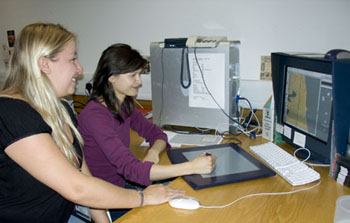
Left: Kati Brauchmann training with Abby Baker in London IDP.
We were delighted in 2005 to sign an agreement with the Staatsbibliothek zu Berlin and the Berlin-Brandenburg Academy of Sciences and Humanities (BBAW) to start collaboration on digitisation and cataloguing of the Chinese, Tibetan, Sanskrit and Syriac fragments in their collections. Details were discussed, in presence of the Japanese cooperators, during the workshop 'Digitalisierung Chinesischer, Tibetischer, Syrischer und Sanskrit-Texte der Berliner Turfansammlung' organized by BBAW at the beginning of June 2005 (see here for papers and photographs). Work started in late 2005 with the financial support of the German Research Foundation. IDP transferred the database in early 2006 and the German website went live in January this year. Kati Brauchmann and Dr Barbara Meisterernst are working on the imaging and cataloguing respectively, supervised by Simone-Christiane Raschmann and with valuable input also from the photographers, IT staff and other researchers of the above mentioned institutions.
Above left: Dr Susan Whitfield, Director of IDP and Barbara Schneider-Kempf, Director General of the Staatsbibliothek zu Berlin - Preußischer Kulturbesitz, at the signing ceremony in Berlin.
Above right: Dr Susan Whitfield, Director of IDP, Katrin Oelgarten, Legal Adviser of the Berlin Brandenburg Academy of Sciences and Humanities and Dr Hartmut-Ortwin Feistel, Director of the Oriental Department of the Staatsbibliothek zu Berlin - Preußischer Kulturbesitz, at the signing ceremony in Berlin.
IDP Japan
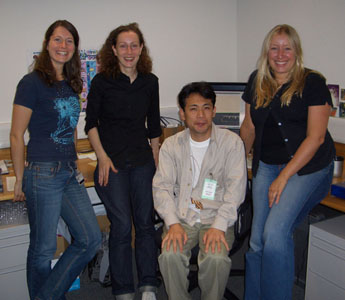 In 2005 IDP held discussions with a group from Ryukoku University, Kyoto, about establishing an IDP Centre in Japan and a Japanese web site. The agreement was signed in 2005 and the database and web site launched in January this year. Sakamoto Shouji will be carrying out imaging and data input work in Japan with support for computer services by other members of staff.
In 2005 IDP held discussions with a group from Ryukoku University, Kyoto, about establishing an IDP Centre in Japan and a Japanese web site. The agreement was signed in 2005 and the database and web site launched in January this year. Sakamoto Shouji will be carrying out imaging and data input work in Japan with support for computer services by other members of staff.
Right: Sakamoto Shouji with IDP London Digitisation Studio Staff, Caroline Smith, Vic Swift and Abby Baker (from l. to r.).
IDP Russia
Since the report in the last newsletter on the launching of the Russian website, several thousand images have been produced for mounting online on IDP and for ArtStor, funded by the Andrew W. Mellon Foundation. The catalogues of the Russian material will be input in 2005.IDP China
IDP China opened in 2001 at the National Library of China (NLC) and has been adding images and data to the database since then. In 2005 the NLC hosted the very successful 6th IDP Conference in Beijing (see Project News). The papers from this will be published in 2007.During discussions held during 2005 between IDP and Zhang Zhiqing, Head of the Rare Books and Special Collections of the NLC, and Lin Shitian, Head of IDP China, it was agreed that the activities of IDP China should be expanded, both to accelerate the rate of digitisation and to increase other activities such as research and educational programmes. The Sino-British Fellowship Trust continues to provide vital funding for China and the new Ford Foundation Project (see Digitisation, Cataloguing & Research) will cover some costs, but further funding is now urgently being sought to develop these plans.
Other Collaborations
IDP has many other collaborations with partners worldwide to digitise, catalogue and research materials. These include the Library of the Hungarian Academy of Sciences, Academia Sinica, the British Museum and the Victoria & Albert Museum (see Digitisation, Cataloguing & Research). In addition, IDP is currently holding discussions with the National Museum of India in New Delhi, the Dunhuang Academy, the Musée Guimet, Paris, the Museum for Indian Art, Berlin and the Hermitage, St Petersburg, about collaboration in digitising and mounting their collections on IDP.Digitisation, Cataloguing & Research
Over the past five years IDP has digitised, catalogued and researched thousands of manuscripts. It now has over 90,000 images online of over 20,000 manuscripts and other artefacts. Below are some of the major projects completed in 2005, ongoing or just starting. 'What's New' on the IDP home page (see overleaf) will tell users of our latest developments, including groups of items newly digitised, newly mounted catalogues and translations and other web developments.
 Projects marked with a Chinese coin still require either full or top-up funding.
Projects marked with a Chinese coin still require either full or top-up funding.
Completed in 2005
 Digitisation of Chinese Dunhuang Manuscripts
Digitisation of Chinese Dunhuang Manuscripts
Over the past four years IDP has digitised almost 4,000 Chinese manuscripts from Dunhuang in the British Library Collections comprising over 40,000 images. This project was funded by the Andrew W. Mellon Foundation and the images are now both on IDP and ArtStor. The project was successfuly completed but there remain over 10,000 Chinese manuscript scrolls and fragments from Dunhuang still requiring digitisation, representing over 100,000 images, and IDP is now seeking funding to continue this core work.
Digitization and Access Enhancement of the Tibetan Dunhuang Manuscripts at the British Library
This three-year AHRC-funded joint project with the School of African and Oriental Studies, London University with lead applicants Dr Ulrich Pagel and Burkhard Quessel, was successfully completed in August 2005. 4,153 digital images were produced by IDP, over 80% of the Tibetan tantric manuscripts. In addition, the two project researchers, Jacob Dalton and Sam van Schaik, completed a fully descriptive catalogue of the Tibetan tantric manuscripts from Dunhuang in the British Library's Stein Collection, comprising 618 separate texts contained in 350 manuscripts. Furthermore, the researchers identified many cases where incomplete British Library manuscripts could be supplemented or completed by manuscripts from the Pelliot collection at the Bibliothèque nationale de France. This was done using the measurements of the Pelliot collection manuscripts, and the microfilms kept at the British Library.Therefore a significant number of the tantric manuscripts from the Pelliot collection were also catalogued. The images and catalogue are now online on the IDP website.
Also as part of this project work was carried out on MY IDP and Sam van Schaik prepared a teaching resource, also now online, for Buddhism in Central Asia.
Manuscripts from Academia Sinica
The 50 Chinese and Tibetan manuscripts held in the Fu Ssu-Nien Library, Institute of History and Philology, Academia Sinica, Taipei, were all digitised and images provided to IDP at the end of 2004. Dr John Kieschnick prepared a catalogue of this material. During 2005 the images were prepared for IDP and the catalogue formatted into XML. Both went online in early 2006.
British Museum Dunhuang Paintings
Dunhuang paintings held at the British Museum were digitised for ArtStor Mellon International Dunhuang Archive, funded by the Mellon Foundation. In 2004-5 these images were prepared for IDP and mounted online. Catalogues of this material are currently being formatted to go online in 2006.
Ongoing
 Digitisation of Stein Photographs from the Library of the Hungarian Academy of Sciences (LHAS)
Digitisation of Stein Photographs from the Library of the Hungarian Academy of Sciences (LHAS)
An agreement between IDP and LHAS has resulted in the start, in 2005, of digitisation of photographs from Stein's first expedition. Over 400 photographs are now online and this project will continue through 2006, with work starting on new material shortly. The catalogues will also be made accessible online.
 Chinese Woodslips in the British Library
Chinese Woodslips in the British Library
Over 1,330 woodslips from Niya and Loulan in the British Library collections were digitised in 2002 as part of a Chinese research project. Following completion of this work, IDP has continued to digitise the remaining woodslips, most in Chinese, as part of its unfunded project work. At present, there are over 7,000 images (recto and verso and some details).
Textiles and artefacts from the V&A and the BM
These two groups of material were digitised inhouse with funding from the Andrew W. Mellon Foundation for inclusion on ArtStor. IDP is now preparing the material for IDP's website and both groups of material will be online by summer 2006.
New Projects Starting 2005/2006
A Palaeographic Study of Chinese and Tibetan Manuscripts from the Dunhuang Collection
This is a 3-year research project funded by the Leverhulme Trust. The project is led by Susan Whitfield with Sam van Schaik and Imre Galambos as principal researchers on the Tibetan and Chinese material respectively.
China, India, Russia: Bringing Together Scholars and Scholarly Resources on the Silk Road
This 2-year Ford Foundation project will start in February 2006. Further details will be given in future issues of IDP News.
 Digitisation & Cataloguing of Sanskrit Fragments
Digitisation & Cataloguing of Sanskrit Fragments
A project part-funded by the International Research Instititute for Advanced Buddhology at Soka University (IRIAB) to enable the conservation, digitisation and research of about 5,000 Sanskrit manuscript fragments at the British Library. The images are sent to an international team for research, coordinated by Professor Karashima Seishi.
 Tangut Manuscript Fragments
Tangut Manuscript Fragments
Work started on conservation and digitisation of the Tangut material in the British Library in 2005. This is important material which has not previously been accessible but, as yet, this work has no funding and its future in 2006 is uncertain.
A Guide to the IDP Website and Database
HOME PAGE
The IDP Home Page gives users an introduction to IDP and offers immediate access to all the web information pages (in the lefthand menu), to the IDP Database (lefthand menu), to a full-text site search and to the latest newsletter. It also carries regularly-updated information on new developments (under What's New). A brief guide to the site is given below. Further, more detailed, guides will be given in future issues and online.

The site has been developed for all browsers on all platforms but users need to have cookies and javascript enabled and popup windows unblocked. You can increase the text size using the browser command.
A basic guide to site navigation is given below and we will be adding animated search tours on the web site itself to show the sites full capabilities. A introduction to the database search is given below.
Comments are welcome. Use Contact Us in the lefthand menu.
IDP DATABASE
This section, which appears on every page, allows you to search the database directly or to go to the Advanced Search pages. See below for further details of these.Please note, the search here only looks in indexed fields and only for records with images. If you get no results it is probable that the item you are looking for is not yet digitised or indexed. You can search for these items in Advanced Search.
MY IDP
MY IDP is a personalised web space that will allow you to keep and modify one or more 'collections' containing your own notes, lists of artefacts, searches, bibiographies and catalogues, and links inside and outside the IDP web site.MY IDP is currently being developed and will go live shortly. Look out for details under What's New.
WHAT'S NEW
The What's New section of the home page will give you the latest information on enhancements to the website and database, including details of new digital images, catalogues and translations.The What's New pages will be archived on IDP Archives (see top left of page) and searchable using the Google IDP Site Search (see top right).
SEARCHING
You can search all the web pages on the IDP site using the Google search (top right). Type any string into the box and you will get a list of IDP web pages containing this string. This is not a search of the IDP database — see below for this.You can also use Google to search the whole www simply by clicking 'www' above the search box.
GENERAL WEBSITE NAVIGATION
TO GO TO......different language versions of the site
Click name of language required on the menu bar at the top right of the home page.

...pages about IDP and its activities
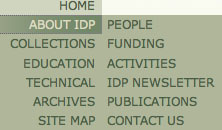 Go to the list of pages in the left hand column. Home, About IDP, Technical, and Archives all give information on IDP. You can click on these pages to get the main (top-level) page, or hold your mouse over these pages to get a list of sub-directories and choose one of those directly.
Go to the list of pages in the left hand column. Home, About IDP, Technical, and Archives all give information on IDP. You can click on these pages to get the main (top-level) page, or hold your mouse over these pages to get a list of sub-directories and choose one of those directly.
The top level page and all sub-pages (with the one you are in highlighted) always shows at the top of each page...

...while the overall site navigation (the top level/main pages) show at the bottom of each page.

...pages about the items, their history and access
Go to Collections and choose by country. Each of these pages gives a summary of the expeditions to Central Asia, the objects acquired, where they are now kept, how to see them and how many are already part of IDP.
Information about the items and their images
See IDP Database and details of searching below.
Help!
Click on Help in the lefthand menu to get a list of frequently asked questions and search tips. If you have a question which is not answered here then please use the Contact Us form, also accessible via the lefthand menu.

Contact Us
Contact Us allows you to join the IDP electronic news mailing list, add your name to the mailing list for a hard copy of the newsletter or simply send a query or comment.

SEARCHING THE DATABASE
SIMPLE SEARCH OF RECORDS WITH IMAGES
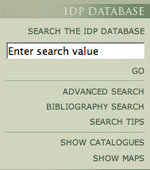 The lefthand menu contains a section called IDP
DATABASE. This is on every page and enables you to search the database from anywhere in the IDP website using the search box. Simply type in a string of characters. This can be a pressmark, a subject, language, archaeological site, holding institution or type of artefact. This is a 'contains' search but, please note, it only searches the indexed fields and only searches records with images. There are over 50,000 records on the database and over 30,000 of these do not have images yet so your search might give no results. In order to search ALL records and using free text, go to Advanced Search (see below).
The lefthand menu contains a section called IDP
DATABASE. This is on every page and enables you to search the database from anywhere in the IDP website using the search box. Simply type in a string of characters. This can be a pressmark, a subject, language, archaeological site, holding institution or type of artefact. This is a 'contains' search but, please note, it only searches the indexed fields and only searches records with images. There are over 50,000 records on the database and over 30,000 of these do not have images yet so your search might give no results. In order to search ALL records and using free text, go to Advanced Search (see below).
ADVANCED SEARCH OF ALL RECORDS
For more sophisticated searching click Advanced Search below the search box. This will take you to the following page and gives you three ways to search.
NOTE: ALL these searches have a 'Show Only Records With Images' choice and this is checked by default. If you get no search results then uncheck this box before searching.
1. Search for Item by Pressmark/Number
Each institution has its own system of giving each item in its collections a unique string. This is the pressmark. For example, British Library Chinese manuscripts from Dunhuang have the suffix 'Or.8210/S.' followed by a number in the range 1-13624. 'Or.' signifies that this item is in the Oriental section of the British Library; '8210' signifies Stein's second expedition and 'S.' stands for Stein.You can search by this string. There is the choice of 'is equal to' or 'contains' search. If you are not certain of the exact string, for example, whether it contains spaces or not, or if you get no search results using 'is equal to' then use 'contains'. You can also use the wildcard '@'. Click the 'Submit' button to search.

2. Search Using Predefined/Indexed Values
There are a number of indexed fields with predefined choices on the database. If you click any of the boxes you will get a list with ALL selected. Click on a choice to reduce selection. Use Alt Click to choose several options. Remember to uncheck 'Only Items with Images' if necessary. There is a reset button to start again.
You can use this, for example, for the following types of search:
- All manuscripts in Chinese or Tibetan in scroll form.
- All items found at Miran.
- All copies of the Avalokitesvarasutra.
- All photographs in the Library of the Hungarian Academy of Sciences
3. Free Text Search in Titles and Catalogue Entries
The database now contains catalogue entries which are free-text searchable. Titles are contained within the catalogues. Simply type in any string/search term here. It will only search the catalogues which we have finished formatting and imported into the database. To view these, click Show Catalogues in the lefthand menu (see below).SEARCH RESULTS
Any of the above searches will bring up a list of items, with a thumbnail. Up to ten items are shown per page and, if the search result is large, only the first 300 items are displayed.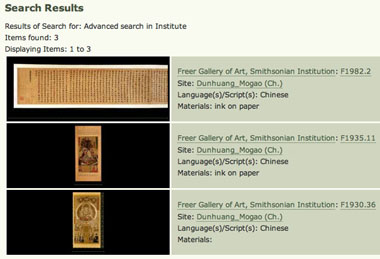
To find out about the holding institution click on the institutional name (eg. Freer Gallery of Art). Note: All images are in copyright and you must contact the copyright holder, listed on this page, for permission to reproduce.
To look at further details of any item, click on the thumbnail or the pressmark. You will then get the following screen.
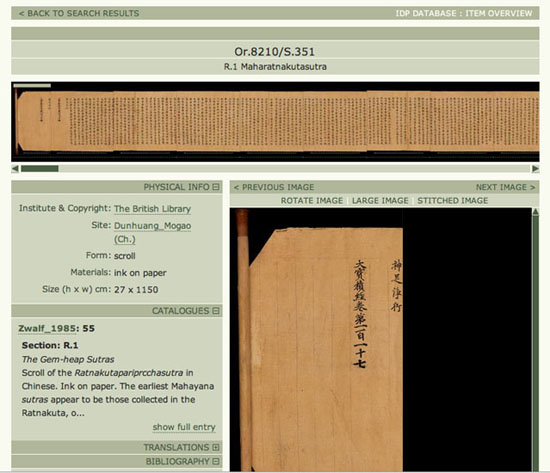
SHOW CATALOGUES
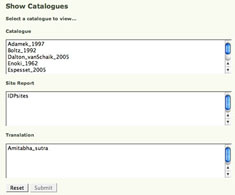 Choosing this option will take you to a page listing the catalogues, translations and files of archaeological site information now on the database. Click to select and press the Submit button. You can navigate from these to items. In 2006 we will add over 10,000 additional catalogue entries.
Choosing this option will take you to a page listing the catalogues, translations and files of archaeological site information now on the database. Click to select and press the Submit button. You can navigate from these to items. In 2006 we will add over 10,000 additional catalogue entries.
BIBLIOGRAPHICAL SEARCH

SHOW MAPS
This part of the site is curently under construction.Uighur Studies in China: A Review
Geng Shimin
55 distinct peoples are recognized in China by the Chinese government, besides the majority Han Chinese. Within these are seven groups speaking Turkic languages, namely, Uighur, Kazakh, Kirghiz, Yughur, Salar, Uzbek, and Tatar. The Kök Munchaq and Heilongjiang Kirghiz also speak Turkic but are not acknowledged as separate groups. The former are included in the Mongols living in Altai Prefecture, Xinjiang Uighur Autonomous Region. According to my investigations in 1955, they belong to the Tuvinian people. The latter are Khaqas people who were moved to Manchuria in the 18th century under the Qing. Here, however, I will concentrate on the Uighurs and the current state of Uighur studies in China.The Uighurs, numbered at 7,207,000,1 live mostly in southern Xinjiang. They are Muslims and most are agriculturalists. The peoples included in this modern 'Uighur' designation are a conglomerate of the ancient Turkic populations of the region (such as the Uighurs, Qarluqs, Basmils,etc.) with an admixture of other ancient populations of the Tarim Basin such as the Tokharians, the Khotanese-Sakas, Sogdians and Han Chinese.
Modern Uighur has three dialects: 1. Central Dialect, which is the largest and is spoken mainly by the Uighurs of the prefectures of Kashgar, Aksu, Korla, Ili, Turfan and Qumul; 2. Khotan Dialect; 3. Lop Nor Dialect, spoken in Lop Nor and Charkhilik counties.
The Current State of Uighur Studies in China
1. Teaching and Research Institutes
BEIJING: Central University for Nationalities, Department of Turkic Languages and Cultures: 4-5 professors/associate professors and several lecturers and assistants teaching Uighur, Kazakh and Kirghiz languages. There are about 300 students every year, coming from Uighur, Kazakh and Kirghiz groups. This Department has the right to award both masters and doctoral degrees. The Centre of Altaistic Studies and Depts of Ethnology and of History also have staff engaged in Uighur teaching.XINJIANG: The University of Xinjiang and the Normal University of Xinjiang both have chairs for Uighur language and literature. Uighur Studies are also pursued in the Kashgar Pedagogical College (in Kashgar) and in the Ili Pedagogical College (in Yining/Kuldja).
Besides Beijing and Xinjiang, Uighur studies are represented in the Northwestern Nationality Institute in Lanzhou, Gansu Province. Recently a new Centre for Nationality Studies (including Uighur Studies) was established in the Shaanxi Normal University in Xi'an.
2. Learned Societies
The following societies produce non-periodic publications and convene symposia.- Society of Turkic Languages Research of China
- Society of Studies on Uighur History and Culture
- Society of Research on the Classical Uighur Literature and 12 Muqams
- Society for Border Studies of China
- Society for Studies on Minority Languages
- Society for Studies on Ancient Nationality Languages and Scripts
- Society for Studies on the Central Asian Culture
- Society of Altaistic Studies (in Hohhot , the capital of Inner Mongolia.)
3. Periodicals
Most of the articles concerning Uighur Studies appear in the following periodicals:BEIJING: Zhongyang Minzu Daxue Xuebao (Bulletin of the Central University for Nationalties); Minzu Yuwen (Languages of Nationalities); Minzu Yanjiu (Nationality Research); Minzu Wenxue (Nationality Literature)
XINJIANG: Xinjiang Daxue Xuebao (Bulletin of Xinjiang University); Xinjiang Shifan Daxue Xuebao (Bulletin of Xinjiang Normal University); Xiyu Yanjiu (Research on Western Region, the Journal of the Xinjiang Academy of Social Sciences); Yuyan He Fanyi (Language and Translation, the Journal of the Language and Script Research Committee of Xinjiang Uighur Autonomous Region, published in Chinese, Uighur, Kazakh, Mongol and Kirghiz languages); Xinjiang Wenwu (Xinjiang Cultural Relics); Xinjiang Wenhua (Xinjiang Culture); Xinjiang Jiaoyu (Xinjiang Education); Hashi Shifan Xueyuan Xuebao (Bulletin of the Kashgar Pedagogical College); Yili Shifan Xueyuan Xuebao (Bulletin of the Ili Pedagogical College)
In addition, there are several literary journals in the Uighur language: Tarim, Tianshan, Bulaq (Spring), Kashgar Literature, Ili Rever, and Yengi Qashteshi (New Jade).
4. Publishers
The following Beijing and Xinjiang publishers also produce works on Uighur Studies: Beijing Nationality Publishers; Xinjiang People's Publishers; Xinjiang Education Publishers; Xinjiang Youth Publishers; Xinjiang Art Publishers; Xinjiang University Publishers; Kashgar Uighur Language Publishers; Ili Publishers.A History of Uighur Studies
Because Uighur and other Turkic peoples have long lived within China, there have been many translators versed in Turkic languages in China. For example, as early as the 5th- century, a Han-Chinese named Liu Shiqing translated the Buddhist Nirvanasutra from Chinese into Old Turkic. Of necessity, many handbooks and glossaries on the Uighur language were compiled, but only a few have survived. These include A Glossary of Gaochang (Turfan) Language (14th c.), Collection of Letters from Turfan (14th c), and A Five-Language Dictionary (Chinese, Manchu, Mongolian, Tibetan, and Uighur) (17-18th c).Strictly speaking, scientific studies in China on the Uighur language started only after 1949. The 1950s saw the establishment of relevant teaching and research organizations and the training of qualified personnel. The systematic investigation of Uighur and other Turkic languages spoken in China was also carried out in this period. In the course of this, I identified the Kök Munchaq language in Altai region as an independent Turkic (Tuvinian) language. From 1953 to 1976 I taught the Kazakh language. Since 1976 I have mainly studied Old Uighur texts.
Uighur Studies was interrupted for reasons well-known and only began to develop again from the late 1970s. Its progress since then can be briefly summarized as below.
Volumes dealing with Uighur language, culture and peoples were published in the following series: Outlines of Minority Languages in China, Outlines of Minority Histories in China, and Gazeteers of Minority Autonomous Regions. Several famous classical works written in Turkic language have been translated into Modern Uighur and Chinese, for example: Maitrisimit, Diwan Lughat-at-Turk, Qutadghu Bilig, Atäbätul Haqayiq, Legend of Oghuz Qaghan, Tarih-i Musiqiyun, and Tarih-i Hamidiya. Many medium and large dictionaries along with textbooks, grammars and other teaching materials concerning Uighur language were also published. A great quantity of the Uighur folkloric materials have been collected and published. Some important Buddhist and Manichaean Uighur manuscripts were discovered, studied and published. Examples of this author's work include2:
- Das Zusammentreffen mit Maitreya (Meeting with Maitreya: the Future Buddha) (Maitrisimit: Hami version) in 2 vols (co-author), Wiesbaden 1989.
- Eine Buddhistische Apokalypse (A Buddhist Book of Revelation) (co-author), Opladen 1998.
- Dasakarmapathavadanamala (Garland of Stories Between Teacher and Pupil) (co-author), TDA 3(1993) & 10 (2000).
- 'A study of one newly discovered folio of the Uighur Abhidharmakosa-sastra', CAJ 33 (1989).
- 'On the Lanzhou version of the Uigur Commentary to the Abhidharmakosabhasya-tika Tattvartha' in M. Olmez, S.-Chr. Raschmann (edd.), Splitter aus Gegend von Turfan. Festschrift für Peter Zieme anläßlich seines 60. Geburtstags, Istanbul-Berlin 2002.
- 'Notes on an Ancient Uighur Official Decree Issued to a Manichaean Monastery', CAJ 35 (1991)
- 'Zerstörung manichäischer Klöster in Turfan' ( co-author) ZAS 18 (1985).
- 'Manis Wettkampf mit dem Prinzen' (co-author) ZDMG 137 (1987).
- 'Die Geschichte der drei Prinzen, Weitere neue manichäischer Fragmente aus Turfan' (co-author) ZDMG 139 (1989).
- 'The Uighur Kingdom of Kocho', in History of Civilization of Central Asia, vol. 4, UNESCO, Paris 1998.
- 'On the Fusion of Nationalities in the Tarim Basin and the Formation of the Modern Uighur Nationality', in Central Asia Survey 3 (1984).
- 'Die alttürkischen Steppenreiche (552-745)', in History of the Turkic Peoples in the Pre-Islamic Period, Berlin 2000.
- Liu Ge and Huang Xianyang (ed.): Xiyu Shidi Lunwen Ziliao Suoyin (Index to the articles about the histories and geographies of Western Region), Xinjiang People's Publishing House, Urumqi 1988 (8032 entries).
- Chen Yanqi and Sasha(ed.): Xiyu Yanjiu Shumu (Bibliography on Western Region's Studies), Xinjiang People's Publishing House, Urumqi 1990 (6734 entries).
- Zhongguo weiwu'er lishi wenhua yanjiuhui bian (Society of Study on Uighur History and Culture of China)(compiled): Weiwu'er lishi wenhua yanjiu wenxian tilu (Bibliography of Research on Uighur's History and Culture), Nationality Publishing House, Beijing 2000 (6980 entries).
The Future
I believe in that in accordance with China's new open policy towards the outside world, Uighur studies in China will continue to prosper. I also believe that there will be excellent possibilities for cooperation between Chinese and foreign scholars.Profesor Geng Shimin is one of the first generation of scholars in new China who mainly worked on the philology of Turkic texts. In 1992 the German Humboldt Foundation awarded him the title of 'Internationally Renowned Scholar' and in 2000 PIAC gace him a gold medal in recognition of his achievements in the field of Turkology.
Abbreviations and notes
CAJ: Central Asiatic Journal
TDA: Türk Dilleri Arastirmalari
ZAS: Zentralasiatische Studien
ZDMG: Zeitschrift der Deutschen Morgenländischen Gesellschaft
1. According to the 4th population census carried out in 1990.
2. Here I only list the most important works. Altogether I have published 16 books and over 150 papers on the history, culture, ancient and modern languages of the Turkic peoples of China. See the bibliography in Geng Shimin, Collection of the Papers on Language-Literature and History of Xinjiang ( in Chinese), Beijing 2001. For works on Uighur Buddhist studies see my recent monograph published in Türkler, cilt 3: 786-800, 2002, Yeni Türkiye, Ankara. The English original of this monograph was published in a series of books, The Turks (vol. 3: 896-910) by the same publisher in 2002.
3. Manichaeism was founded by Mani in the 3rd century. From 8th-11th centuries this religion was the official religion in the Uighur Khanate of Mongolia and continued in the Uighur Kingdom of Kocho (Turfan).
*It is a great honour for me to dedicate this short paper to the jubilar who published several excellent papers on Uighur texts. So here I mainly speak on Uighur, especially on Old Uighur Studies in China.
Professor L.N. Menshikov (1926-2005)
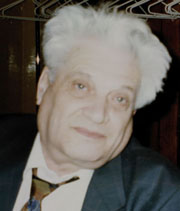 It is with deep sadness that I learned of the death of Professor Lev. N. Menshikov in late 2005 following a long illness.
It is with deep sadness that I learned of the death of Professor Lev. N. Menshikov in late 2005 following a long illness.
I first met Professor Menshikov when he spoke in October 1993 at the conference which resulted in the forming of IDP. He was enthusiastic from the start and he remained one of our most ardent, learned and delightful supporters.
His scholarship, especially his cataloguing of the Russian collections and work on the bianwen texts, is familiar to and respected by everyone involved with Dunhuang studies. He was prolific, publishing around 250 works, including 15 monographs and several important translations, most inspired by the rich collections of Dunhuang material at the Institute of Oriental Studies, St. Petersburg Branch of the Russian Academy of Sciences.
Professor Menshikov did undergraduate studies at Leningrad State University and proceeded directly to graduate work at the Institute of Oriental Studies. He completed these in 1955 and immediately became a researcher at the Institute where he remained until his death. He will be sorely missed by his colleagues and students.
Apart from his published works, Professor Menshikov was a great ambassador for the rich tradition in Russia of Chinese and Dunhuang studies. He travelled widely and gave conference presentations in Chinese, English, Russian — or a mixture of the three, as appropriate. And in the many conference interstices he was always a convivial companion.
Professor Menshikov's contribution to Chinese and Dunhuang studies is immense. But I am sure I will not be alone in remembering him also for his charm, wit and friendship.
Susan Whitfield, IDP
Education
Alastair Morrison
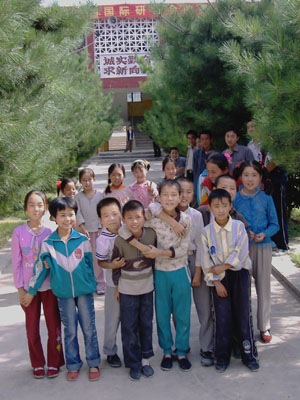 In 2005 IDP prepared a bilingual DVD of resources relating to the history of Dunhuang. This was distributed to primary-school teachers in Gansu Province, China in collaboration with the EU-China Gansu Basic Education Project (GBEP). GBEP has assisted the Gansu Provincial Government in implementing education reform through the use of technology in some of the remotest, poorest areas in Gansu. The IDP resource aims to introduce local schoolchildren to Dunhuang's history through popular stories with accompanying images including Mogao cave paintings, manuscripts, and landscapes. Also featured are music, maps and video-clips of performances at the British Library by London schoolchildren inspired by the same stories.
In 2005 IDP prepared a bilingual DVD of resources relating to the history of Dunhuang. This was distributed to primary-school teachers in Gansu Province, China in collaboration with the EU-China Gansu Basic Education Project (GBEP). GBEP has assisted the Gansu Provincial Government in implementing education reform through the use of technology in some of the remotest, poorest areas in Gansu. The IDP resource aims to introduce local schoolchildren to Dunhuang's history through popular stories with accompanying images including Mogao cave paintings, manuscripts, and landscapes. Also featured are music, maps and video-clips of performances at the British Library by London schoolchildren inspired by the same stories.
In August 2005, I attended the EU-China GBEP International Conference in Lanzhou, Gansu which addressed the sustainability of the Teacher Learning Resource Centres across the province beyond the project end. These centres provide a space for teachers from several villages to meet, plan lessons, and pool resources, and most are equipped with DVD players and computers with Internet access. Field trips were organised, some requiring six-hour bus journeys over inhospitable mountain terrain. I visited a village primary school in Qin'an county with over 100 children (some pictured right) and 15 teachers, where we were shown two classes. In both other teachers were observing at the back and taking notes. We also visited the resource centre equipped with a computer and TV with VCR/DVD players. Teachers visit from the surrounding areas and training materials are taken to remote areas by motorbike.
We are awaiting feedback on the resource from the project, and hope that children from diverse ethnic backgrounds in Gansu can learn about their own heritage and the part it played in creating the cultural richness of the province.
Project News
People
We were very sorry to say goodbye in 2005 to James Alexander, Computer Support Engineer, and Caroline Smith, Photographer. Both have been essential and valued members of the IDP team for several years. James will continue working on a consultancy basis for IDP preparing the new map interface. We welcome Stephen Porthouse as James's replacement as Support Engineer.6th Conservation Conference
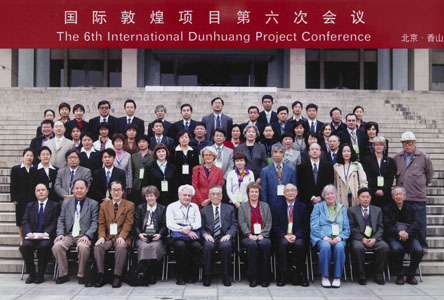 The 6th IDP Conference was held in Beijing between 22-25 April 2005, excellently organised by the National Library of China (NLC). Participants from all IDP's main collaborating partners attended giving presentations on recent conservation work in their organisations. In addition there were over 20 presentations by conservators from throughout China.
The 6th IDP Conference was held in Beijing between 22-25 April 2005, excellently organised by the National Library of China (NLC). Participants from all IDP's main collaborating partners attended giving presentations on recent conservation work in their organisations. In addition there were over 20 presentations by conservators from throughout China.
The conference delegates had the opportunity to see the impressive new Dunhuang manuscript storage facilities at the NLC. These are specially-built camphor-wood cupboards. The manuscripts are stored inside scroll boxes and placed inside the cupboard drawers. The cupboard, which are themselves inside a secure and temperature and humidity-controlled area of the basements, are locked.
The conference papers will published in a bilingual Chinese-English volume, edited by Lin Shitian and Alastair Morrison.
